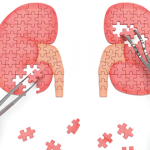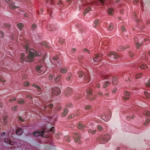The FSGS subtype carries the worst prognosis, is less responsive to glucocorticoids, and has higher rates of relapse and subsequent progression to end-stage renal disease.3 As in our patient’s case, the recommendations is to treat the FSGS subtype of lupus podocytopathy more aggressively, with glucocorticoids and immunosuppressive agents for both induction and maintenance therapy.
Immunomodulatory agents reported in observational studies of lupus podocytopathy include MMF, calcineurin inhibitors, cyclophosphamide and rituximab.13 Mycophenolate mofetil and cyclophosphamide are two commonly used treatments for lupus nephritis, but their use can be limited by gastrointestinal toxicity and myelosuppression, respectively. Calcineurin inhibitors stabilize the podocyte cytoarchitecture, in addition to their role in T cell inhibition, and are shown to have better remission rates in lupus podocytopathy.14 When used, consideration of renal dose adjustment is required, and caution must be taken in those with an eGFR of <45 mL/min. Rituximab has also been shown to have protective benefits on the podocyte cytoarchitecture and improves cell adhesion, in addition to its B cell depleting effect.15
Lupus podocytopathy can present with or without extra-renal manifestations of SLE. In a study involving 125 renal biopsies, 31 of which were characterized as a podocyte group with >50% FPE and nephrotic syndrome, less extra-renal involvement was reported.16 However, in other studies, extrarenal SLE manifestations not limited to malar rash, oral sores, arthritis and cytopenia were reported.3 Our patient did not have any extra-renal manifestations.
According to the current classification criteria of lupus nephritis, some lupus podocytopathy cases may be classified as lupus nephritis class 1 or class 2, due to the presence of mesangial deposition and mesangial proliferation, and we might not proceed with aggressive immunosuppressive treatment. The clinical picture may mimic class 5 membranous lupus nephritis due to significant proteinuria. Hence, multidisciplinary collaboration with pathology and nephrology is essential in recognizing and managing this entity.
Conclusion
Lupus podocytopathy should be suspected when patients with SLE present with nephrotic range proteinuria, absent subendothelial or subepithelial immune deposits on renal biopsy and diffuse foot process effacement. This can histologically present as class 1 or class 2 lupus nephritis, or clinically as class 5 lupus nephritis. It is important to recognize lupus podocytopathy to select the most appropriate treatment regimen given the high risk of relapse.
Despite the importance of establishing the diagnosis of lupus podocytopathy, there remain significant gaps in the literature, especially in describing the efficacy of treatment regimens.

